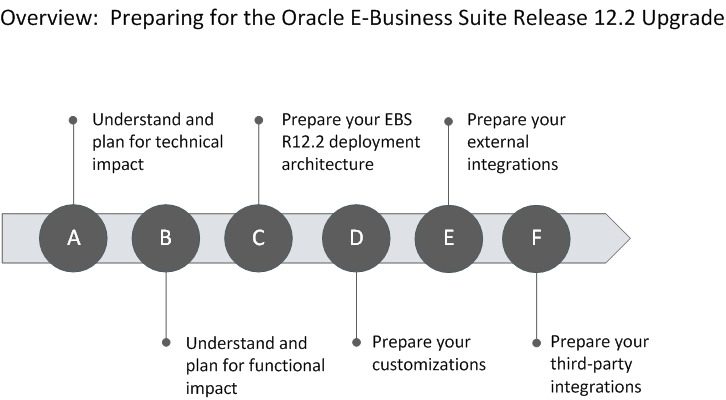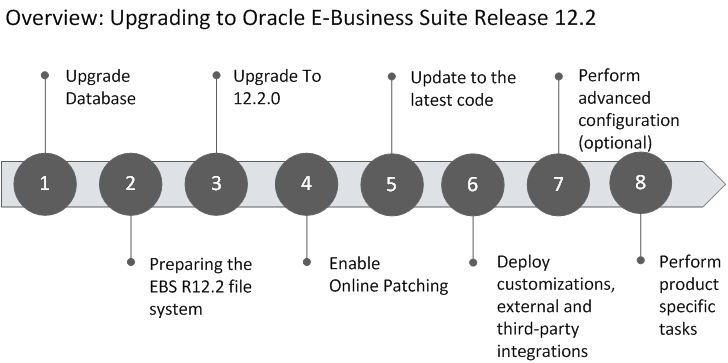Overview of the Upgrade
This chapter covers the following topics:
- Upgrade and Requirements
- Understanding the Upgrade Flow and Process
- Scheduling Time for an Upgrade
- Testing the Upgrade
Upgrade and Requirements
This guide provides instructions for upgrading existing Oracle E-Business Suite technology stack and products from Release 12.0 and Release 12.1 to Release 12.2, and supports on premises upgrades. This guide also provides instructions for upgrading an existing Oracle E-Business Suite Release 12.1.3 instance to Oracle E-Business Suite Release 12.2 on Oracle Cloud infrastructure.
This and other Release 12.2 documents are updated as required. Ensure that you have the most current version of all guides and documents before you begin your system upgrade.
Additional Resources: Refer to Oracle E-Business Suite Documentation Web Library for the latest versions of relevant guides.
Supported Upgrade Paths
Oracle supports direct upgrades from Oracle E-Business Suite Release 12.0 and 12.1 to Oracle E-Business Suite Release 12.2.
Upgrading to Oracle E-Business Suite Release 12.2 requires your database to be at the minimum version 11.2.0.4. To complete the upgrade to Release 12.2, you must upgrade your database to 11.2.0.4 or higher. Additional details are covered in Chapter 4, Performing the Upgrade, Preparing the Database for the Upgrade.
Required Action: You must refer to My Oracle Support Knowledge Document 1349240.1, Database Preparation Guidelines for an Oracle E-Business Suite Release 12.2 Upgrade, for comprehensive instructions specific to your current Oracle E-Business Suite instance and the required Oracle Database version.
Additional Resources: Database de-support schedules have important operational and planning implications for Oracle E-Business Suite environments. Oracle strongly recommends that you review the following My Oracle Support Knowledge document that details the latest database support policies and de-support schedules: Release Schedule of Current Database Patch Sets (Doc ID: 742060.1).
Understanding the Upgrade Flow and Process
The upgrade process has been enhanced and streamlined. New features have been added to Rapid Install and AutoPatch to increase their capabilities.
Rapid Install provides the latest certified versions of Oracle E-Business Suite products, including technology stack components. In an upgrade, it creates the new file system for the application tier components and the new file system for the database. After the upgrade, run Rapid Install again to configure the application tier.
An upgrade also includes various manual steps, including some that direct you to run scripts or apply patches. Use adpatch to apply Oracle E-Business Suite patches, including the unified driver which upgrades the Oracle E-Business Suite Database objects to Release 12.2.0. After Online Patching Enablement is complete, adop is used to apply all Oracle E-Business Suite patches.
This guide contains information regarding technical and functional impact and changes due to the upgrade. It is very important that your DBA and your functional specialists work together to review this information carefully as a part of upgrade planning. Doing so will help to prevent unexpected delays during and after the upgrade.
Overview of Planning and Preparing for the Upgrade
There are a number of tasks that should be performed prior to starting the upgrade. The information to help you plan for and prepare for the upgrade are documented in the following chapters within this guide:
-
Understanding Upgrade Impact and Changes
-
Planning and Performing Pre-Upgrade Tasks
The following diagram describes the high-level overview of the tasks described in this guide:

Overview of the Oracle E-Business Suite Release 12.2 Upgrade Process
The steps required to upgrade to Oracle E-Business Suite Release 12.2 are documented in the Performing the Upgrade chapter. The upgrade includes a number of steps that can be categorized into the following high level steps:

The following is a summary of the steps for each category:
-
Prepare the Database.
-
Upgrade the database to the minimum version or latest certified version
-
Migrate to a new platform (optional)
-
Apply the latest database patches
-
-
Lay Down the Oracle E-Business Suite Release 12.2 File System.
-
Use Rapid Install to lay down the file system and technology stack
-
Apply the latest application tier technology stack patches
-
-
Upgrade to Release 12.2.0.
-
Apply the latest AD upgrade patch and Oracle E-Business Suite Consolidated Upgrade Patch (CUP)
-
Apply the latest Oracle E-Business Suite pre-install patches
-
Apply the 12.2 merged upgrade driver
-
Run Rapid Install in 'configure' mode
-
-
Enable Online Patching.
-
Apply the latest Online Patching Readiness Report Patch
-
Apply required updates to custom code according to the readiness reports
-
Apply the enablement patch
-
-
Upgrade to the latest code.
-
Apply the latest AD-TXK RUP
-
Apply the latest Oracle E-Business Suite Release 12.2 Release Update Pack (RUP)
Note: You must apply the 12.2.3 or later Release Update Pack (RUP) to your existing Release 12.2 system for production use.
RUPs are released periodically. Each one is cumulative and delivers error corrections and system updates, not only for the most current release update pack, but also for all the RUPs that precede it. Oracle highly recommends that when planning your upgrade you plan to upgrade to the latest RUP available.
You can keep current on the latest release information, as well as new RUP announcements and other updates that may affect your upgrade by reviewing the latest version of Oracle Applications Manager Release Notes for Release 12.2.
-
Complete post-upgrade steps
-
Apply the latest security patches
-
Apply all recommended patches
-
Apply NLS patches (conditional)
-
-
Deploy custom code, external integrations and third-party integrations.
-
Perform advanced configurations.
-
Scaling up and scaling out, such as adding additional managed servers, adding application tier nodes, or adding Oracle RAC nodes.
Supported in EURC-DT: Yes
Note: The upgrade process is performed with one application tier and one database tier. If you are using an Oracle RAC environment, then you should run the Release 12.2 upgrade on a single Oracle RAC node. The reason for upgrading with a single Oracle RAC node is that most of the elapsed time in the upgrade will be taken by jobs running DML (INSERT, UPDATE, DELETE). These jobs use multiple workers and parallel servers, which typically attempt to access the same objects and blocks concurrently. The consequent additional communication between cluster nodes (and associated cluster waits) significantly outweigh any gains from using the additional CPU's to increase throughput. Scaling out is a post-upgrade step.
-
Secure configuration
-
DMZ configuration
-
Disaster recovery setup
-
Reporting environment setup
-
-
Perform product specific tasks.
-
Some products include tasks that must be performed after the upgrade is complete
-
The required steps are covered in detail in the following chapters in this upgrade guide:
-
Performing the Upgrade
-
Performing Post Upgrade Tasks
Scheduling Time for an Upgrade
Before scheduling a time for the upgrade, you should perform several iterations of the upgrade in a non-production environment. The goal of multiple iterations is to confirm the required steps and reduce the time required to perform the upgrade.
In an upgrade, critical system downtime refers to the period of time when users cannot log on to the system or use Oracle E-Business Suite. There are several actions you can take to reduce this downtime period.
Suggested Reading: Some tasks and steps in subsequent chapters may be performed in parallel. There are also steps you can take to improve the timing of certain tasks. For guidelines to improve the performance of the upgrade and reduce the downtime required to perform the upgrade, refer to the following:
-
Best Practices for Minimizing Oracle E-Business Suite Release 12.2.n Upgrade Downtime (Doc ID: 1581549.1)
-
Express Diagnosis of Oracle E-Business Suite Release 12.2.n Upgrade Performance Issues (Doc ID: 1583752.1)
After you have optimized your upgrade plan and finalized testing, you will have an estimate for the amount of time required to perform the upgrade in production. You can then schedule the time required for the upgrade to your production environment.
Testing the Upgrade
Oracle suggests that you perform a test upgrade using a copy (clone) of your existing system, and hardware that is similar to your production system to provide a baseline for upgrade execution times and an opportunity to work out any upgrade issues ahead of time. Oracle also recommends several upgrade tests, especially for customized systems.
When upgrading Oracle E-Business Suite, it is essential to ensure that the performance of key operations continues to meet requirements after the upgrade. Oracle recommends that you upgrade Oracle E-Business Suite in a test environment, and then conduct a benchmark test with the configuration, product mix, and user load that simulates current and expected workloads. Controlled conditions help verify performance prior to the upgrade of your production environment.
Additional Information: For additional information, refer to Oracle E-Business Suite Performance Best Practices (Doc ID: 2528000.1).